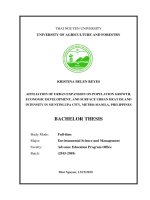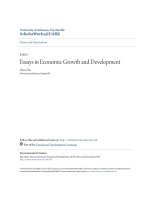Economic growth and economic development 327
Bạn đang xem bản rút gọn của tài liệu. Xem và tải ngay bản đầy đủ của tài liệu tại đây (141.48 KB, 1 trang )
CHAPTER 7
Review of the Theory of Optimal Control
The previous chapter introduced the basic tools of dynamic optimization in discrete time. We will now review a number of basic results in dynamic optimization in
continuous time–particularly the so-called optimal control approach. Both dynamic
optimization in discrete time and in continuous time are useful tools for macroeconomics and other areas of dynamic economic analysis. One approach is not superior
to another; instead, certain problems become simpler in discrete time while, certain
others are naturally formulated in continuous time.
Continuous time optimization introduces a number of new mathematical issues.
The main reason is that even with a finite horizon, the maximization is with respect
to an infinite-dimensional object (in fact an entire function, y : [t0 , t1 ] → R). This
requires us to review some basic ideas from the calculus of variations and from
the theory of optimal control. Nevertheless, most of the tools and ideas that are
necessary for this book are straightforward.
We start with the finite-horizon problem and the simplest treatment (which is
much more similar to calculus of variations than optimal control) to provide the
basic ideas. We will then move to the more powerful theorems from the theory of
optimal control as developed by Pontryagin and co-authors.
The canonical problem we are interested in can be written as
Z t1
f (t, x (t) , y (t)) dt
max W (x (t) , y (t)) ≡
x(t),y(t)
0
subject to
x˙ (t) = g (t, x (t) , y (t))
and
y (t) ∈ Y (t) for all t, x (0) = x0 ,
313









